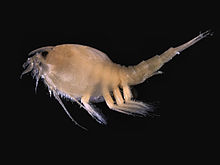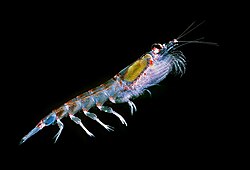Systematik der Höheren Krebse
Die folgende Systematik der Höheren Krebse zeigt die Zugehörigkeit der unterschiedlichen rezenten Taxa in der Klasse der Höheren Krebse (Malacostraca), meist bis zur Familienebene.
Früher war eine andere Einteilung gebräuchlicher, bei der die Zehnfußkrebse oder Decapoda in die beiden Unterordnungen Reptantia und Natantia eingeteilt wurden. Die Natantia umfassten die frei schwimmenden Formen (meist als Garnelen bezeichnet), die Repatantia die benthischen, am Gewässergrund lebenden, neben den Astacidea, Anomura und Brachyura wurden die Langustenartigen oder Palinura als Teilordnungen der Repantia aufgefasst. Eine weitere Einteilung fasste alle Gruppen mit gut ausgebildetem Pleon, also alle außer den Brachyura und Anomura, zur Unterordnung Macrura zusammen.[1] Diese Systeme werden heute nicht mehr verwendet, weil die unterschiedenen Taxa zum Teil nicht monophyletisch sind, das System also nicht die natürliche Verwandtschaft der Gruppen abbildet.








Unterklasse Eumalacostraca
- Unterklasse Eumalacostraca
Überordnung Eucarida
- Überordnung Eucarida
- Ordnung Zehnfußkrebse (Decapoda)[2]
- Unterordnung Dendrobranchiata
- Überfamilie Penaeoidea
- Familie Aristeidae
- Familie Benthesicymidae
- Familie Penaeidae
- Familie Sicyoniidae
- Familie Solenoceridae
- Überfamilie Sergestoidea
- Familie Luciferidae
- Familie Sergestidae
- Überfamilie Penaeoidea
- Unterordnung Pleocyemata
- Teilordnung Achelata
- Familie Langusten (Palinuridae)
- Familie Bärenkrebse (Scyllaridae)
- Teilordnung Mittelkrebse (Anomura)
- Überfamilie Aegloidea
- Familie Aeglidae
- Überfamilie Chirostyloidea
- Familie Chirostylidae
- Familie Eumunididae
- Familie Kiwaidae
- Überfamilie Galatheoidea
- Familie Springkrebse (Galatheidae)
- Familie Munididae
- Familie Munidopsidae
- Familie Porzellankrebse (Porcellanidae)
- Überfamilie Hippoidea
- Familie Maulwurfskrebse (Albuneidae)
- Familie Blepharipodidae
- Familie Sandkrabben (Hippidae)
- Überfamilie Lithodoidea
- Familie Hapalogastridae
- Familie Stein- und Königskrabben (Lithodidae)
- Überfamilie Lomisoidea
- Familie Lomisidae
- Überfamilie Einsiedlerkrebse (Paguroidea)
- Familie Landeinsiedlerkrebse (Coenobitidae)
- Familie Linkshändige Einsiedlerkrebse (Diogenidae)
- Familie Rechtshändige Einsiedlerkrebse (Paguridae)
- Familie Tiefsee-Einsiedlerkrebse (Parapaguridae)
- Familie Pylochelidae
- Familie Pylojacquesidae
- Überfamilie Aegloidea
- Teilordnung Großkrebse (Astacidea)
- Überfamilie Flusskrebse (Astacoidea)
- Familie Astacidae
- Familie Cambaridae
- Überfamilie Enoplometopoidea
- Familie Riffhummer (Enoplometopidae)
- Überfamilie Nephropoidea
- Familie Hummerartige (Nephropidae)
- Überfamilie Parastacoidea
- Familie Parastacidae
- Überfamilie Flusskrebse (Astacoidea)
- Teilordnung Axiidea
- Familie Axiidae
- Familie Geistergarnelen (Callianassidae)
- Familie Callianideidae
- Familie Calocarididae
- Familie Ctenochelidae
- Familie Eiconaxiidae
- Familie Micheleidae
- Familie Strahlaxiidae
- Familie Thomassiniidae
- Teilordnung Krabben (Brachyura)
- Teilordnung Caridea
- Überfamilie Alpheoidea
- Familie Knallkrebse oder Pistolenkrebse (Alpheidae)
- Familie Barbouriidae
- Familie Putzer- und Marmorgarnelen (Hippolytidae)
- Familie Ogyrididae
- Überfamilie Atyoidea
- Familie Süßwassergarnelen (Atyidae)
- Überfamilie Bresilioidea
- Familie Agostocarididae
- Familie Alvinocarididae
- Familie Bresiliidae
- Familie Disciadidae
- Familie Pseudochelidae
- Überfamilie Campylonotoidea
- Familie Bathypalaemonellidae
- Familie Campylonotidae
- Überfamilie Crangonoidea
- Familie Crangonidae
- Familie Glyphocrangonidae
- Überfamilie Galatheacaridoidea
- Familie Galatheacarididae
- Überfamilie Nematocarcinoidea
- Familie Eugonatonotidae
- Familie Nematocarcinidae
- Familie Tanzgarnelen (Rhynchocinetidae)
- Familie Xiphocarididae
- Überfamilie Oplophoroidea
- Familie Oplophoridae
- Überfamilie Palaemonoidea
- Familie Anchistioididae
- Familie Desmocarididae
- Familie Euryrhynchidae
- Familie Hummelgarnelen (Gnathophyllidae)
- Familie Kakaducarididae
- Familie Felsen- und Partnergarnelen (Palaemonidae)
- Familie Typhlocarididae
- Überfamilie Pandaloidea
- Familie Tiefseegarnelen (Pandalidae)
- Familie Thalassocaridae
- Überfamilie Pasiphaeoidea
- Familie Glasgarnelen (Pasiphaeidae)
- Überfamilie Physetocaridoidea
- Familie Physetocarididae
- Überfamilie Procaridoidea
- Familie Procarididae
- Überfamilie Processoidea
- Familie Processidae
- Überfamilie Psalidopodoidea
- Familie Psalidopodidae
- Überfamilie Stylodactyloidea
- Familie Stylodactylidae
- Überfamilie Alpheoidea
- Teilordnung Gebiidea
- Familie Axianassidae
- Familie Laomediidae
- Familie Schlammhummer (Thalassinidae)
- Familie Upogebiidae
- Teilordnung Glypheidea
- Überfamilie Glypheoidea
- Familie Glypheidae
- Überfamilie Glypheoidea
- Teilordnung Stenopodidea
- Familie Macromaxillocarididae
- Familie Schwamm-Scherengarnelen (Spongicolidae)
- Familie Scherengarnelen (Stenopodidae)
- Teilordnung Polychelida
- Familie Polychelidae
- Teilordnung Achelata
- Unterordnung Dendrobranchiata
- Ordnung Leuchtgarnelen (Euphausiacea)
- Familie Bentheuphausiidae
- Familie Krill (Euphausiidae)
- Ordnung Zehnfußkrebse (Decapoda)[2]
- Überordnung Eucarida
Überordnung Ranzenkrebse (Peracarida)
- Überordnung Ranzenkrebse (Peracarida)
- Ordnung Flohkrebse (Amphipoda)
- Unterordnung Gammaridea
- Unterordnung Hyperiidea
- Unterordnung Ingolfiellidea
- Unterordnung Senticaudata[3]
- Teilordnung Bogidiellida
- Teilordnung Carangoliopsida
- Teilordnung Corophiida
- Teilordnung Gammarida
- Teilordnung Hadziida
- Teilordnung Talitrida
- Ordnung Cumacea
- Ordnung Asseln (Isopoda)
- Unterordnung Anthuridea
- Unterordnung Asellota
- Unterordnung Calabozoidea
- Unterordnung Epicaridea
- Unterordnung Flabellifera
- Unterordnung Gnathiidea
- Unterordnung Microcerberidea
- Unterordnung Landasseln (Oniscidea)
- Unterordnung Phreatoicidea
- Unterordnung Valvifera
- Ordnung Lophogastrida
- Ordnung Mictacea
- Ordnung Schwebegarnelen (Mysida)
- Familie Lepidomysidae
- Familie Mysidae
- Familie Petalophthalmidae
- Familie Stygiomysidae
- Ordnung Spelaeogriphacea
- Ordnung Scherenasseln (Tanaidacea)
- Ordnung Thermosbaenacea
- Ordnung Flohkrebse (Amphipoda)
- Überordnung Ranzenkrebse (Peracarida)
Überordnung Syncarida
- Überordnung Syncarida
- Ordnung Anaspidacea
- Familie Anaspidesidae (syn. Anaspididae)
- Familie Koonungidae
- Familie Psammaspididae
- Familie Patagonaspididae
- Familie Stygocarididae
- Ordnung Brunnenkrebse (Bathynellacea)
- Familie Bathynellidae
- Familie Parabathynellidae
- Ordnung Anaspidacea
- Überordnung Syncarida
Unterklasse Hoplocarida
- Unterklasse Hoplocarida
- Ordnung Fangschreckenkrebse (Stomatopoda)
- Unterordnung Unipeltata
- Ordnung Fangschreckenkrebse (Stomatopoda)
Unterklasse Phyllocarida
- Unterklasse Phyllocarida
- Ordnung Leptostraca
- Familie Nebaliidae
- Familie Nebaliopsididae
- Familie Paranebaliidae
- Ordnung Leptostraca
Siehe auch
- Systematik der Senticaudata
Quellen
- Joel W. Martin, George E. Davis: An Updated Classification of the Recent Crustacea. Hrsg.: Natural History Museum of Los Angeles (= Science Series. Band 39). 2001, S. 124 (Online [PDF; 756 kB; abgerufen am 17. Februar 2012]).
- Malacostraca im Integrated Taxonomic Information System (ITIS). Abgerufen am 17. Februar 2012.
Einzelnachweise
- ↑ Hans-Eckhard Gruner: Klasse Crustacea. in: H.E. Gruner (Hrsg.): Arthropoda (ohne Insecta). Lehrbuch der Speziellen Zoologie (begründet von A.Kaestner). Band 1, 4. Teil. Gustav Fischer, Stuttgart / Jena 1993, ISBN 3-334-60404-7, auf Seite 979.
- ↑ Sammy De Grave, N. Dean Pentcheff, Shane T. Ahyong et al.: A classification of living and fossil genera of decapod crustaceans. In: Raffles Bulletin of Zoology. Supplement No. 21. 2009, S. 1–109 (Online [PDF; 7,8 MB; abgerufen am 18. Februar 2012]).Online ( des vom 6. Juni 2011 im Internet Archive) Info: Der Archivlink wurde automatisch eingesetzt und noch nicht geprüft. Bitte prüfe Original- und Archivlink gemäß Anleitung und entferne dann diesen Hinweis.
- ↑ James K. Lowry & Alan A. Myers: A Phylogeny and Classification of the Senticaudata subord. nov. (Crustacea: Amphipoda). Zootaxa, 3610, 1, S. 1–80, 2013
Auf dieser Seite verwendete Medien
Autor/Urheber: Die Autorenschaft wurde nicht in einer maschinell lesbaren Form angegeben. Es wird Pedrosanch als Autor angenommen (basierend auf den Rechteinhaber-Angaben)., Lizenz: CC BY-SA 3.0
Bogavante escondido en los restos del San Andres hundido sobre los -30m en Tarifa, España, Zona del Estrecho de Gibraltar. Agosto 2005. Temperatura del agua 15° C.
© Hans Hillewaert, CC BY-SA 4.0
This leptostracan was sampled on the Belgian Continental Shelf in 2004. Length 5.5 mm (carapax 3 mm). Image Taken with an Axiocam (Zeiss) camera mounted on a Zeiss Stemi C-2000 binocular microscope. Geo-location not applicable as the picture was later taken in the lab.
Autor/Urheber: Der ursprünglich hochladende Benutzer war Aquaimages in der Wikipedia auf Englisch, Lizenz: CC BY-SA 2.5
Pederson's Shrimp (Periclimenes pedersoni), Bonaire, Dutch Antilles. Image taken by Clark Anderson/Aquaimages.
Autor/Urheber: Die Autorenschaft wurde nicht in einer maschinell lesbaren Form angegeben. Es wird Pedrosanch als Autor angenommen (basierend auf den Rechteinhaber-Angaben)., Lizenz: CC BY-SA 3.0
Langosta Espinosa, Panulirus argus. Jul-2004. Parque Nacional Morrocoy. Tucacas. Venezuela
Autor/Urheber: Massimiliano DE MARTINO, Lizenz: CC BY-SA 3.0
it:Sicyonia carinata
© Hans Hillewaert, CC BY-SA 4.0
Sand ghost shrimp from the Belgian coastal waters.
Autor/Urheber:
- Krill666.jpg: Uwe Kils I am willing to give the image in 1700 resolution to Wikipedia Uwe Kils
Antarctic krill Euphausia superba. This is the startimage of the virtual microscope http://www.ecoscope.com/cybermic/index.htm of krill where you can click into details of the animal to get higher magnifications, like the gills, the feeding basket or the swimming legs, up to raster electron and transmission electron images, also some videos - there are many links to jumpoff sites for educators, like from the SCIENCE MAGAZINE. In natural hovering position - the red organs produce the bioluminescence - the hepatopancreas is filled with green phytoplankton, the food of krill, the strait gut in the back is filled with the empty shells of phytoplankton - in the front you see the compound eye
(c) Stan Shebs, CC BY-SA 3.0
Photo of Munida quadrispina at the Birch Aquarium in San Diego
Autor/Urheber: User:Haplochromis, Lizenz: CC BY-SA 3.0
Rhynchocinetes durbanensis
© Hans Hillewaert, CC BY-SA 4.0
Commensal amphipod, taken with Axiocam (Zeiss) camera mounted on a Zeiss Stemi C-2000 binocular microscope. This amphipod was sampled on the Belgian Continental Shelf in 1997.
Autor/Urheber:
André Karwath aka Aka
, Lizenz: CC BY-SA 2.5Dieses Bild zeigt eine 10 mm große männliche Mauerassel (Oniscus asellus). Danke an Andreas Böttger für das Beschaffen des Tieres und danke an Achim Raschka für die Bestimmung.



















